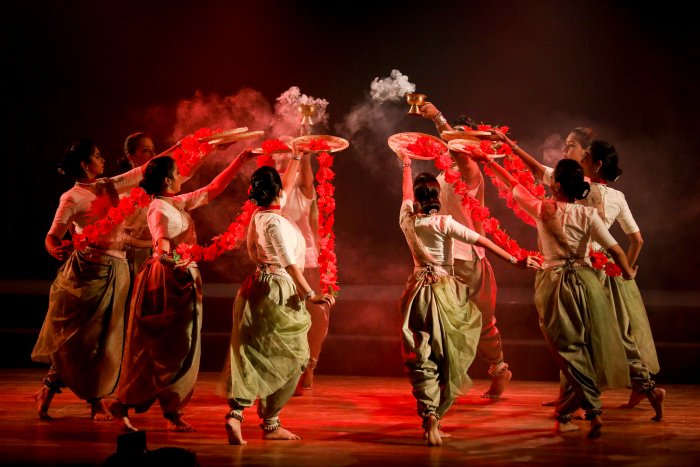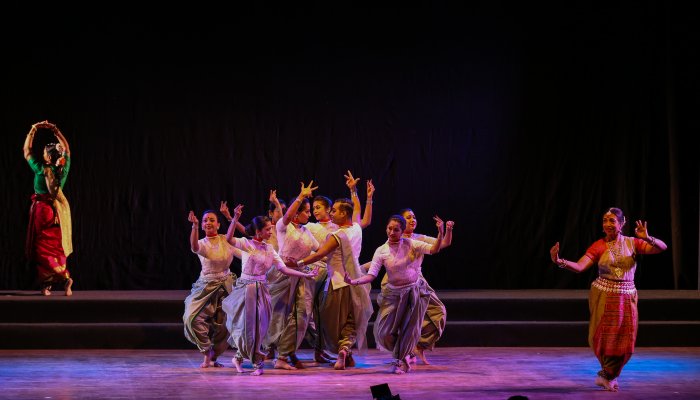
|   |

|   |
If petals could speak, what stories would they tell - Vijay Shanker e-mail: vijaydance@gmail.com May 4, 2022 John Keats, one of the English romantic poets, had remarked, "A thing of beauty, is a joy forever", referring to nature and its magnificent splendour in varied colours and dimensions. Furthermore Kalidasa refers to nature in 'Ritu Samhara' and 'Meghadootam' pertaining to seasons and the impact of nature on man and its varied implications, It is believed that nature is divine, the closer man is to nature, the more happy and healthy he would remain. Nature has always been an integral part of Indian classical dance, as many thematic presentations have dealt with this interesting subject.  It was a pleasant surprise to witness the unusual thematic presentation 'Petal Stories' incorporating five beautiful flowers with the hidden message of reaching out and for better well being and living, presented by Daksha Mashruwala's Kaishiki Nritya Bhasa and Anusree Bonnerjee's Drutam dance ideas lab, portraying five beautiful and fragrant flowers like Champa (magnolia), Parijaat (night jasmine), Gulbahar (daisy), Java Kusum/Jaswanti (hibiscus) and Kamal (lotus). The dancers attired in light green dhoti with a creamish top symbolic of the flowers represented, commenced with slow and steady movements of the hands and limbs, revealing the blooming of flowers. The movements were simple but striking, changed a little according to the nature and temperament of each flower, flowing simultaneously to the melody and harmony of the music. The dance medium was Odissi, Bharatanatyam, folk dance and creative movements that suited the sensibility and sensitivity of the subject of flowers that spreads its fragrance consistently during nights and days too. A little story was revealed. The small daisy aspires to become a sunflower, as she is struck with the magnificent blooming of the sunflowers when the sun shines brightly. Her dream is fulfilled but unfortunately does not last long as due to heavy rainfall and thunderstorms the sunflowers are all destroyed but there are no regrets as the daisy is happy that she lived the life of a sunflower and enjoyed the sunshine in all its brilliance. Another episode which was dramatised was the encounter of demon Raktabeej with the goddess Kali and ultimately the defeat of evil over good and doom of Raktabeej, enacted powerfully by Namrata Mehta as Kali and Nilesh Singha as Raktabeej.  What stood out in the entire production was the melodious music, synchronized and harmonious movements, dancing in fine uniformity. All the performers are trained classical dancers, and it was a spectacle to watch all of them, dancing with involvement and passion. The dancers were Namrata Mehta, Nilesh Singha, Namaha Mazoomdar, Siddhi Waikar, Triya Bonnerjee, Anjali Nigam, Niveditha Ravishankar, Anuradha Sanghvi, Alapayani Dey, Sohini Dasgupta and Ayan Banerjee. Concept, choreography and direction are by Daksha Mashruwala and Anusree Bonnerjee, script by Sudipta Dhruva and music by Kaustuv K. Ganguli. The orchestral team consisted of guitar by Raja Choudhury, sarod by Prattyush Bannerjee, sitar by Rahul Chatterjee, tabla by Joydeep, mardal by Rohan Dahale, mridangam, chollus and kanjira by Satish Krishnamurthy and keyboard by Samrat Chakravarty. Daksha Mashruwala said, "It's been a long time that we have been working on this subject and for the first time two dance institutes in different styles have come together in a collaborative effort and I am glad the result is amazing." The program took place on April 16, 2022 at Veer Savarkar auditorium in Mumbai.  Vijay Shankar is a Kuchipudi and Kathakali exponent, teacher, bilingual journalist, arts critic and actor. |